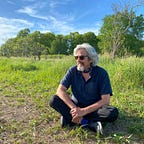Emily Dickinson Banishes the Air
Her poetry dares us to divides the light
Air. Light. Cubes. Drop. Pellets. Shape. Films. Odors. Flame. Steam.
What do these ten nouns have in common?
If I had to guess, I would say: some sort of high school science lab experiment, circa mid-20th century.
Or I might surmise — correctly — that an Emily Dickinson puzzler awaited me.
But that’s the beauty of Dickinson’s bottomless treasure chest of poems. Hundreds of her poems have been scrutinized and analyzed, inspected and dissected, by scholars and ordinary readers alike. In grappling with these selections, you can always find a lot of intelligent help. But many other poems still await a visit from the exegetes and the bloggers. You’ll need to be comfortable proceeding in the dark.
The latest cryptogram from Dickinson’s chest of wonders dares you to banish air and divide light and see what happens. Phantasmagoria ensues.
Banish Air from Air —
Divide Light if you dare —
They’ll meet
While Cubes in a Drop
Or Pellets of Shape
Fit
Films cannot annul
Odors return whole
Force Flame
And with a Blonde push
Over your impotence
Flits Steam.
Wow and sigh. I love it. And I have no idea what she’s talking about.
A mystic science
Dickinson certainly seems to be thinking about science. She compressed ten nouns, all of which would be at home in a science lab, into a short 39-word poem.
In fact, Dickinson had more than a passing interest in the science of her time. It has been noted that more than 270 of her poems touch on scientific themes relating to physics, astronomy, chemistry, geology, botany, physiology, medicine, mathematics, and technology.
She was taught the natural sciences as a student at the Amherst Academy and again during her year at the rigorous Mt. Holyoke Female Seminary (now Mt. Holyoke College) whose founder, Mary Lyon, was not only a pioneer in women’s education but also a trained chemist who required students to learn the new science of laboratory experimentation. Dickinson mentioned her interest in science class in letters to her childhood friend Abiah Root and her brother Austin.
Additionally, she lived in a home filled with books, including books like Elementary Geology by geologist and Amherst College president (and family friend) Edward Hitchcock, Elements of Geometry and Trigonometry by French mathematician A. M. Legendre, and The Stars and the Earth, Or Thoughts upon Space, Time, and Eternity by Felix Eberty, an amateur German astronomer whose works none other than a young Albert Einstein later read and enjoyed.
(The Dickinson family library has been archived and digitized by Harvard University, and you can access and read these 3 arcane books in their entirety, if you are so inclined.)
Whether Dickinson pored over these volumes, I don’t know. But I do know that she read the Romantic poets preceding her, and they explored — and deplored — how the emerging 19th century sciences were “unweaving the rainbow” and banishing nature’s unfathomable mysteries.
In “The Prelude,” William Wordsworth wrote that
Science appears but, what in truth she is,
Not as our glory and our absolute boast
But as a [substitute], and a prop
To our infirmity.
Science, he said, was a
false secondary power, by which,
In weakness, we create distinctions, then
Deem that our puny boundaries are things
Which we perceive, and not which we have made.
John Keats wrote in his lengthy poem “Lamia” that science
will clip an Angel’s wings,
Conquer all mysteries by rule and line,
Empty the haunted air, and gnomed mine —
Unweave a rainbow.
In “Sonnet — To Science,” a young Edward Allan Poe confronted Science for preying upon the poet’s heart, “you Vulture whose wings are dull realities.” In his dramatic fashion, he accuses Science of dragging the mythic deities from their places in the sky, the woods, and the waters, and tearing from him “the summer dream beneath the tamarind tree.” (Poe’s formidable intelligence soon got the better of him, and he became greatly interested in astronomy and physics.)
But Dickinson was unlike her worried poetical predecessors. Just as imagination for Dickinson was a boundless and invisible realm, so too were the new 19th century sciences that explored a world lying beyond our ordinary senses: atoms, electromagnetism, the germ theory of disease, evolution, thermodynamics.
William Blake (whose poetry was in the Dickinson family library) said: “What is now proved was only once imagined.” Dickinson knew that science would never “empty the haunted air” and subdue the sublime. Consider this poem, written by Dickinson in 1865:
A science — so the Savans say, [“savants”]
“Comparative Anatomy” —
By which a single bone —
Is made a secret to unfold
Of some rare tenant of the mold -
Else perished in the stone -
So to the eye prospective led,
This meekest flower of the mead
Opon a winter’s day,
Stands representative in gold
Of Rose and Lily, manifold,
And countless Butterfly!
Dickinson here shows no fear of the emerging science of palaeontology which can look into the deep past and unfold secrets about an ancient bone and its prior “tenant.” Her own eye is “prospective led” and sees how the meekest golden flower in a wintry meadow foretells the beauty of the next season. Thus, what is “perished in the stone” is balanced by the Rose, Lily, and Butterfly, which are “manifold,” “countless.”
Awe is unquantifiable.
Rebel angel
Dickinson came of age in a period of fiery religious revivalism across New England. The Calvinist theology of Amherst was stricter than the emerging Unitarian Christianity firmly rooted in faraway Boston and Cambridge.
In the early 19th century, Calvinist faith and science were not inherently incompatible arenas of thought. Three hundred years earlier, John Calvin himself held that science and reason were gifts from God to man and that “in despising the gifts, we insult the Giver.” The observance and study of nature would reveal God’s presence in the world.
Science, it was said, was a Minister of God.
By the 1860’s, however, profound disputes between scientists, intellectuals, and theologians were playing out in the pages of New England periodicals like the Atlantic Monthly and Harper’s (both still in print!) that Dickinson read in her own home.
The 1859 publication of Charles Darwin’s On the Origin of the Species alone heralded a new crisis of faith. The pace of new scientific reasoning and discovery could not be tamed or modulated by theology or suppressed by church fiat, and this was the talk of the knowledgeable classes.
Quietly at home, Dickinson struggled not with the scientists but with the ministers. Consider this poem, dated c. 1865:
The Chemical conviction
That Nought be lost
Enable in Disaster
My fractured Trust —
The Faces of the Atoms
If I shall see
How more the Finished Creatures
Departed me!
Dickinson here is certainly not offering a Christian view of what awaits us after death. “The world,” she said in an early letter, “holds a predominant place in my affections. I do not feel that I could give up all for Christ, were I called to die.” She struggled fiercely with faith and doubt in so many poems, and in this one she tells of a “fractured Trust” over what awaits after “Disaster,” which in this context sounds like Death. The religious convictions of her family, her church, and her era provided no balm.
What “enables” her is, instead, a “chemical conviction.” Nothing in the universe is lost, according to the science of Dickinson’s day (and ours). The matter and energy in the universe are, in effect, deathless. It is Science, not Faith, that enables her in Disaster.
What a beautiful atomic vision the poem’s second stanza offers! If the speaker could see the “Faces of the Atoms” of which she is made, all the more would she know these “finished creatures” that depart from her. Since they are “finished” with being Emily, these particles — which cannot be lost because nought will be lost — will return instead to the cosmos. We are stardust, Dickinson is saying, anticipating Joni Mitchell (in her song “Woodstock”) by a full century.
Year after year, as family and friends dutifully “converted” to Calvinist Christianity, Dickinson refused. As a young student, she famously declined to stand when the imposing headmistress at Mt. Holyoke Female Seminary, Mary Lyon, asked the students to rise if they believed in Christ or hoped to believe. Dickinson remained a “no-hoper.”
And so she remained for the rest of her life, eventually declining to even attend church on Sundays. In an 1862 letter, Dickinson tartly remarked of her family: “They are religious -except me — and address an Eclipse, every morning — whom they call their father.” And elsewhere she slyly noted, “We dignify faith when we can cross oceans with it — though most prefer ships.”
In one of her more famous poems, Dickinson explains how her faith is found in the outdoors:
Some keep the Sabbath going to Church –
I keep it, staying at Home –
With a Bobolink for a Chorister –
And an Orchard, for a Dome –
Some keep the Sabbath in Surplice –
I, just wear my Wings –
And instead of tolling the Bell, for Church,
Our little Sexton — sings.
God preaches, a noted Clergyman –
And the sermon is never long,
So instead of getting to Heaven, at last –
I’m going, all along.
All the way to heaven is heaven, so look around. Right here, Dickinson reminds us, heaven is here in the orchard with the bobolink.
In so many ways, Dickinson was truly different from her people, place, and time, and she knew it. (“What makes a few of us so different from others? It’s a question I often ask myself,” she said as a teenager in a letter to her brother.) I cannot conceive of the inner strength and courage she needed — and possessed — to survive as a brilliant, self-aware, and uncompromising woman in an era of stifling religiosity and patriarchy.
Unconventional, idiosyncratic, peculiar in thinking — all at a time with no tolerance for divergence from the proper social graces and religious obeisance. She was, as Adrienne Rich said, “Vesuvius at home.” A quiet volcano in the heart of Amherst.
It comes as no surprise that she was comfortable with scientific principles and theories and found poetry there.
On to the poem
Below is Dickinson’s handwritten poem. Good luck reading it. It is fitting and ironic that the first barrier in gaining access to her world is her handwriting.
“Banish Air from Air” was written in 1864 or 1865 during Dickinson’s most fecund period of poetry writing. She did not choose it for one of her “fascicles,” the hand-crafted booklets that, unbeknownst to even her own family members, she carefully created and organized for years. (In all, Dickinson quietly bound 814 poems into 40 fascicles that were not discovered until after her death.)
Likewise, her posthumous editors did not select “Banish Air from Air” in the 1890s when three volumes of Dickinson’s work were published in quick succession and, to everyone’s astonishment, met with instant public interest and acclaim. “Banish Air from Air” remained unknown until its inclusion in Bolts of Melody, a 1945 volume of “new” Dickinson poems. By this time she had been recognized as “one of the great poets of the world,” as the scholar Mark Van Doren noted in his preface.
So, we’ve had almost 80 years to figure it out. Here it is again:
Banish Air from Air —
Divide Light if you dare —
They’ll meet
While Cubes in a Drop
Or Pellets of Shape
Fit
Films cannot annul
Odors return whole
Force Flame
And with a Blonde push
Over your impotence
Flits Steam.
We cannot control the natural world that envelops us, I think she is telling us. We are powerless — impotent — to rearrange the fundaments of reality. The narrative voice in the poem seems to laugh as she goads us to try.
Those first two lines: “Banish Air from Air — / Divide Light if you dare — ”. I hear a gentle laugh in the voice as she dares us to “banish air from air.” It is a lovely impossibility. Didn’t you know that nature abhors a vacuum?
Then she dares us to divide the light. Since there’s nothing out of the ordinary about dividing a ray of light — after all, that is the ordinary work of prisms and rainbows — perhaps Dickinson’s second challenge is to separate light from air, and that is another paradoxical notion.
Your experiment will fail, she tells us in line 3, because “they’ll meet” anyway. Air and light will meet, as they must, because that is how Nature works. We humans cannot separate what Nature does not wish to separate.
The next three lines are mystifying: air and light will meet “While Cubes in a Drop/ Or Pellets of Shape/Fit.” The phrase “cubes in a drop” creates an odd mental image of a geometrical box inside a falling water drop.
Cubes, like the straight lines and angles of which they are made, are mathematical abstractions. When they are present in the real world, they must have been made by human hands or by the technologies that are extensions of our hands.
“Cube” is a word that Dickinson used only twice in writing. In searching the Emily Dickinson Archive for the word “cube” in her poems and letters, there are only two instances: in the poem I am discussing and in a letter she wrote in 1880 to a family friend. As in many of her letters, Dickinson switches from prose to poetry when she advises her friend, “We shall find the cube of a rainbow -/ of that — there is no doubt -/ But the Arc of a Lover’s conjecture/ Eludes the finding out -.” Solving the science of a rainbow is easier, she is saying, than solving the mysteries of romance. How lucky to have been on Dickinson’s mailing list. Can you imagine opening your mail and finding correspondence as remarkable as this?
Drops of water are the opposite. They are real in nature, ephemeral, and shape-shifting. Cubes and drops belong to different, seemingly irreconcilable realms of human existence. And although 19th century scientists were indeed looking at the action of splashing water (I own a book containing an 1894 lecture poetically entitled The Splash of A Drop and Related Phenomena), no one was cubing the drop.
Dickinson also imagines “pellets of shape.” Pellets such as beads or globules do not come in abstract mathematical shapes like triangles or squares.
What are these absurd phenomena she has imagined, and what might they mean?
Science cannot force a pellet into a fixed shape any more than it can put a cube inside a drop. And yet, in the mind of this poem, these impossible geometries somehow “fit.” That single word on its own line in the middle of the poem draws attention to itself. “Fit” fits, both for form and sense.
A one-word poetic line is uncommon, and Dickinson did not employ it often. Here it achieves a powerful (and modern) effect: “fit” functions, visually and substantively, as the fulcrum for the entire poem.
In the poem thus far, we have been told, I think, that with our sciences and measurements we mere humans cannot banish, divide, or otherwise control the properties of our unified universe. And the unimaginable exists as part of this unity, even though we haven’t yet imagined it. Remember William Blake: “What is now proved was only once imagined.”
Then the poem pivots to its message of our impotence. A film is a membrane or a veil that covers or separates or obscures, but here it is ineffective for any such purpose. It will not divide the light. And odors cannot be banished from the air. The unity of things cannot be undone, the rainbow cannot be unwoven.
The line “Force Flame” is a conundrum. Which is the noun, which the verb? Perhaps both are nouns, acting together to feed their natural energy into the final volcanic image where, like “Blonde” lava hissing and steaming down the landscape, the overpowering fire and heat in these final images “push/ over your impotence” as a reminder of our limitations and insignificance in the natural order.
All of this is sheer speculation about Dickinson’s intended meaning. What else is new? She will keep us all unwrapping her mystery gifts for centuries. If a proper Dickinson scholar has looked closely at this poem, I wish I knew about it. More meaning can be extracted, perhaps, by reading this poem in relation to others in which Dickinson addressed the same ideas or themes or used the same words.
But for the time being, I am content to stop here in wrestling with this poem. Truth is, I really am not sure I know what it means. But Dickinson has long prepared me to accept uncertainty in reading her unique work and to exercise creativity — even more than research — in trying to understand her.
References
In addition to the Emily Dickinson Archive, I used the following resources, all of which make for great reading if you really want more.
White, Fred D. “Sweet Skepticism of the Heart: Science in the Poetry of Emily Dickinson,” College Literature (1992).
Franklin, R.W. “The Emily Dickinson Fascicles,” Studies in Bibliography (1983).
Loeffelholz, Mary. “What is a fascicle? Reading Emily Dickinson’s manuscript books,” Harvard Library Bulletin (1999).
Gaull, Marilyn. “Under Romantic Skies: Astronomy and the Poets,” The Wordsworth Circle (1990). I specifically acknowledge finding the William Blake quote here.
Kohler, Michelle. “The Apparatus of the Dark: Emily Dickinson and the Epistemology of Metaphor,” Nineteenth-Century Literature (2012).
https://www.amherst.edu/news/archives/classroom/node/439610
https://hollisarchives.lib.harvard.edu/repositories/24/resources/6412



